A few years ago, I threw some Buffalo Grass seeds (Bouteloua dactyloides) into a patchy area of our backyard. Buffalo Grass is a short, native prairie grass. Because it is so adapted for our hot Texas environment, it doesn’t need much care. It stays 3-8 inches high without mowing, is quite drought tolerant, and it thrives in the sun. It’s a much better alternative to non-native turf grasses, such as Bermuda Grass. Of course, Bermuda Grass was what existed in our backyard when we started the take-back process back in 2008, the goal being to transform our yard into a wildlife haven.
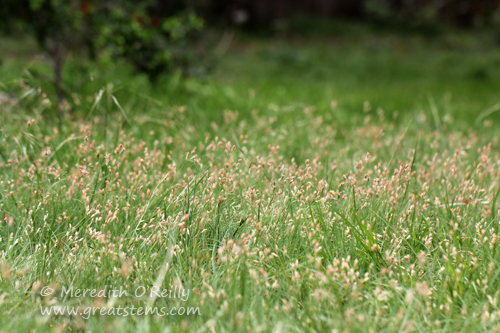
I hoped for success, but I hadn’t done any ground preparation — our garden was at its very beginning stages at the time, and I had other priorities, namely getting perennials established in the butterfly garden area. I threw the seeds out into the yard, mainly because I worried they’d lose their viability before I’d ever have a chance to prep the soil, and I figured at least that way they’d have a chance to get started. Fortunately, there were some patches of dirt where the Bermuda Grass had been scorched to death by the sun, then tilled, so to speak, by our rambunctious dogs. The Buffalo Grass seeds were on their own, subject to the elements, to potential smothering by Bermuda, and to getting gobbled up by birds or trampled by dogs. But happily some Buffalo Grass did sprout, and each season I’d see more and more Buffalo Grass seed stalks show up. Each time, I’d try to let them complete their cycle, so that more grass would grow.
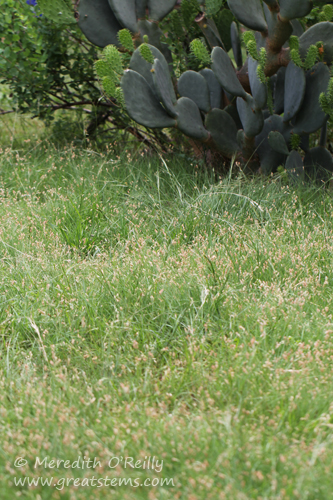
This spring, our Buffalo Grass patch is quite dense, with only a few spots of weeds that I’m plucking out by hand. The thin gray-green blades billow softly in the breeze, and the effect is quite lovely.
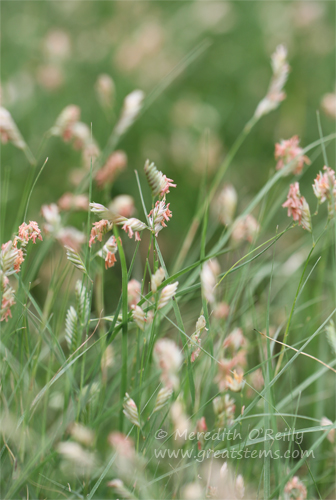
Right now, the patch is covered with inflorescences, or grass flowers. Buffalo Grass is dioecious, meaning that male and female flowers occur on separate plants.
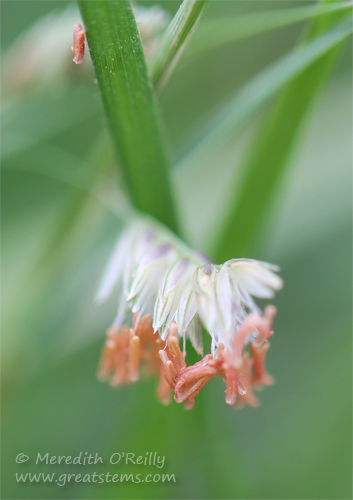
Right now, I’m seeing mostly male inflorescences, but I have to assume that female flowers will show up soon. When they do, they will appear in little clusters low on the plant.
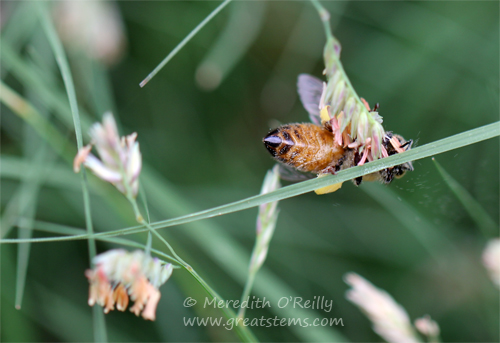
Bees and other pollinators are busy in the Buffalo Grass patch. I admire the tenacity of the honeybees — they are so heavy that when they land on the blade of grass, they weigh it down toward the ground. But there is plenty of pollen to be had, at least. Look closely at the photo above — see the grains floating in the air, just past the bee’s head?
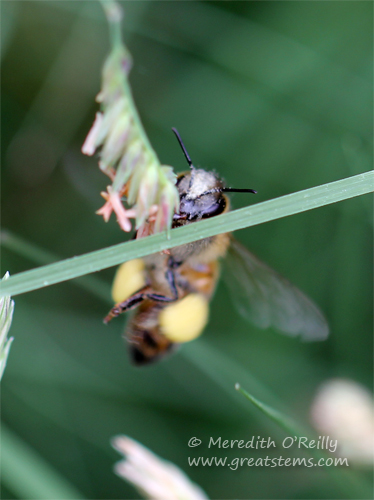 You can also see how big the pollen sacs are on this little honeybee.
You can also see how big the pollen sacs are on this little honeybee.
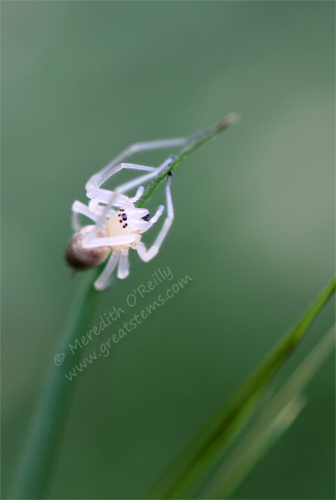
While basking in the awesomeness of my little Buffalo Grass patch, I noticed another visitor. This young spider tried to pretend it was an inflorescence at the top of a blade of grass. Be the flower… be the flower. My friend Spider Joe helped narrow down the ID to a likely Cheiracanthium inclusum, an American Yellow Sac Spider — or possibly a member of the Anyphaenidae family. Spider Joe and I agree that it’s pretty cute, whichever species it is. 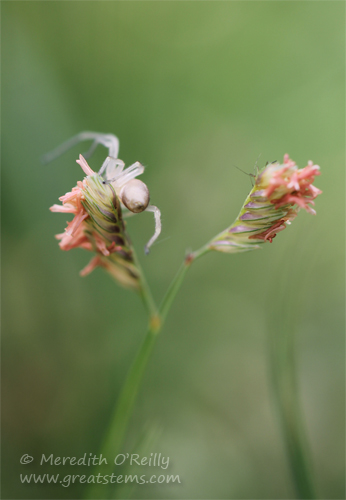
The little spider soon decided to just move to a blade with an inflorescence already present — perhaps it will have a better chance of catching an unsuspecting pollinator that way.
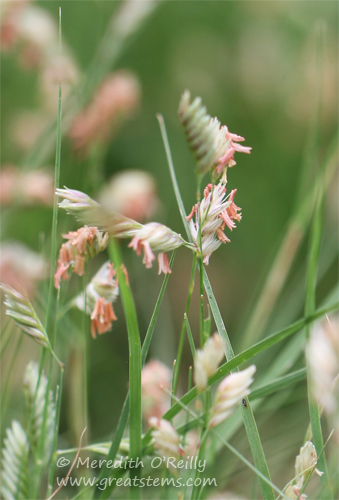 And so it grows, does my Buffalo Grass patch. With luck, the female inflorescences will appear soon, and soon thereafter, so will seeds. Lucky for me, Buffalo Grass also spreads by stolons, or above-ground runners — where the plant touches the ground, it can take root. Sometimes Buffalo Grass roots can reach 5-6 feet into the ground, but most will be closer to the surface of the soil. I suspect my Buffalo Grass patch has relied on a lot on spreading by stolons — this is just fine with me. It can do so right up near my garden beds, too — it won’t be hard to keep it out of the beds. Not like Bermuda, the grass of nightmares.
And so it grows, does my Buffalo Grass patch. With luck, the female inflorescences will appear soon, and soon thereafter, so will seeds. Lucky for me, Buffalo Grass also spreads by stolons, or above-ground runners — where the plant touches the ground, it can take root. Sometimes Buffalo Grass roots can reach 5-6 feet into the ground, but most will be closer to the surface of the soil. I suspect my Buffalo Grass patch has relied on a lot on spreading by stolons — this is just fine with me. It can do so right up near my garden beds, too — it won’t be hard to keep it out of the beds. Not like Bermuda, the grass of nightmares.
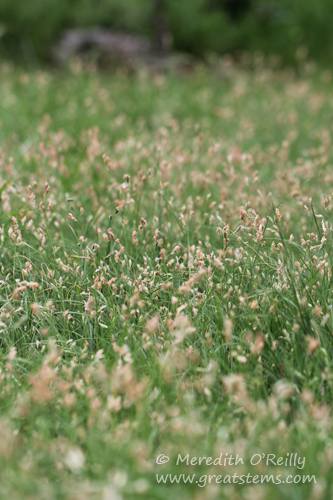
What thrills me is that the Buffalo Grass seems to be naturally winning against the more aggressive Bermuda Grass. Usually you hear the opposite scenario! Perhaps it’s because I limit the Bermuda’s spread by never watering it and by keeping it cropped short before it goes to seed (at least, I try to keep it cropped). I don’t water the Buffalo Grass either, actually, but I do let it go to seed, and there’s no reason to mow it more than a couple of times a year.
What it means is that I have hope that one day in the relatively near future I might be able to rip out the remaining Bermuda and get the Buffalo Grass to fully take over. I’m not fooling myself into thinking the Bermuda Grass will just give up and die. But I see the possibilities, and each year the area of Bermuda Grass shrinks. My Buffalo Grass has become an ally in the endeavor to rid the yard of Bermuda, and as I dig out Bermuda roots, layer in cardboard and mulch to build new beds, and give the non-native turf the evil eye, the Bermuda Grass shrinks, and the Buffalo Grass has a chance to grow even stronger.
My buffalo grass area has almost completely been taken over by weeds, or at least grassy weeds (or weedy grasses?). The buffalo grass is still under there, but it’s not the wonder it was the first year I planted (from plugs). I’m not really sure what to do about it, other than apply chemicals.
Alan, could they be winter grasses? Will they die back?
The more water and/or fertilizer that buffalo grass gets, the more the weeds take over. This means that it will be more maintenance in wet years than in dry – and, even more importantly, you should never fertilize it and almost never water it. This is really hard to keep from doing, since we receive so many messages about the need to “care for” our lawns on TV and in gardening magazines, etc.
You don’t say where you are located, but buffalo grass becomes harder to grow the further east you are, mainly because of the increased moisture.
Meanwhile, mow low and, if you have the time, try to handpull and throw away any weeds that are trying to set seed. Best of luck!
Thanks for all the advice, Cynthia. Sounds like we are on the right path, I hope, I hope!
I’ll bet your female flowers are already there – when they say “low on the plant”, they mean almost at ground level, hidden among the grass blades. You won’t see the female flowers unless you go looking for them, which is why most commercially produced buffalo grass, used for lawn plugs, is some type of female clone.
We just plugged buffalo grass two summers ago, during the horrible summer of 50+ days over 100, and it has filled in nicely. We’ve got 2 relatively small patches, so I handweed, although I don’t need to do much of that any more, as the grass has filled in so thickly.
Your patch is so pretty! Thanks for showing it off.
I kept telling my in laws to stop fertilizing (or if they’re going to fertilize, to use compost) their buffalo grass lawn. They finally started to listen a year or so ago when they found out that the grass stayed greener when they used Revitalizer Compost instead of the weed n feed. They do, however, insist on watering 2 – 3 times a week, and they mow it regularly – but then, tis the problem with living in Sun City where the lawns must be green and manicured. They also don’t believe me when I say that buffalo will not grow in the shade – they keep putting out seed at a location that gets more shade than sun and don’t get why it won’t grow. I tell them to pull the planting bed out further to take over that area, but they want the grass, not more mulch….oh well, I’ll keep working on them, soon they’ll come around to seeing my side of things.
You’re telling them all the right things, Katina. Keep working on them! The more they water and fertilize, the more they are encouraging weeds to grow, not Buffalo Grass. If they don’t want to extend the planting beds, mulch under the trees can look very nice. Just a thought.